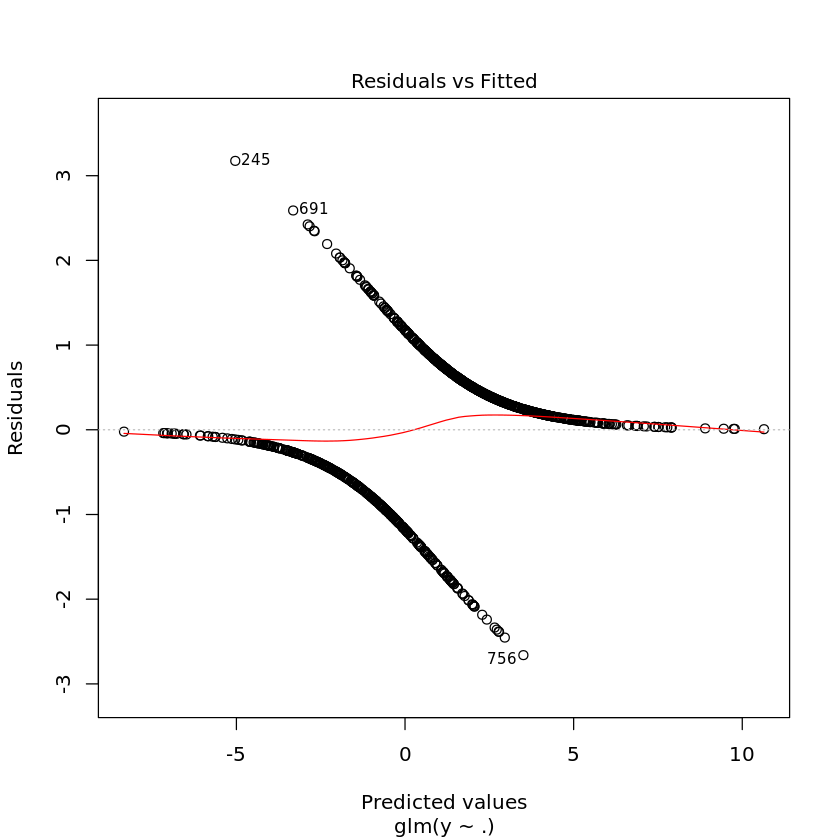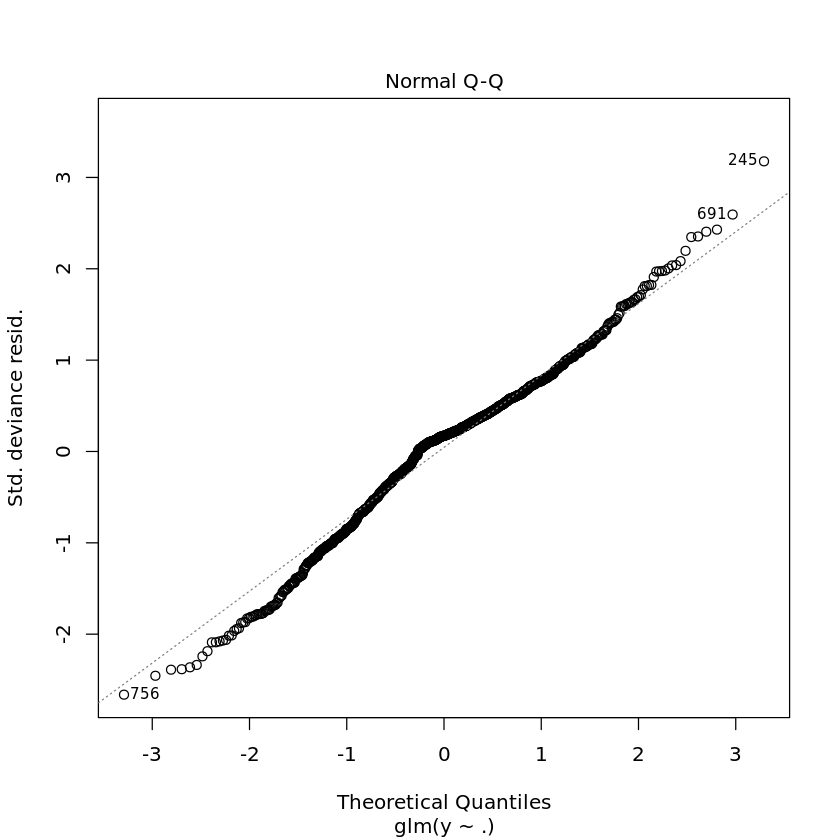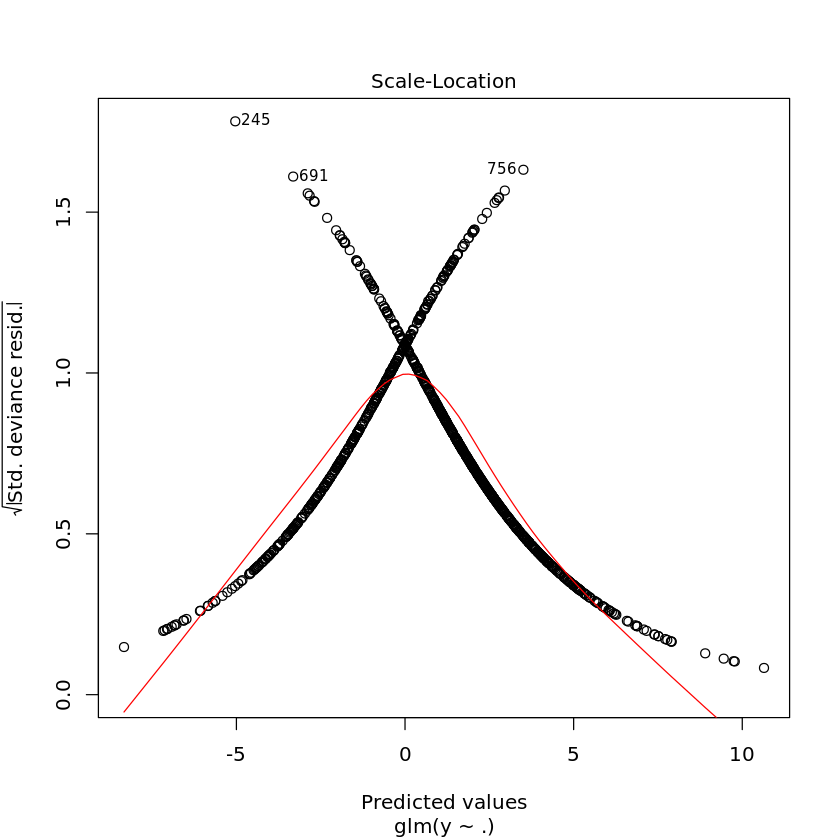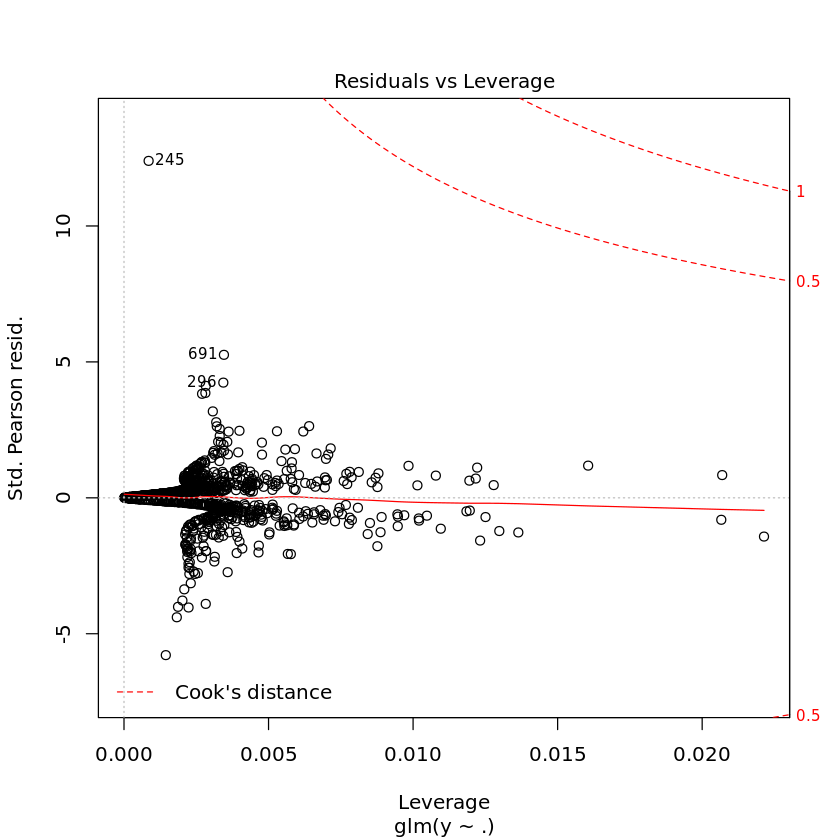2. Logistic Regression
2.1. Generate data
Below, we simulate data.
\(X_1 \sim \mathcal{N}(0, 1)\)
\(X_2 \sim \mathcal{N}(0, 1)\)
\(Y_0 = 1 + 2X_1 + 3X_2 + \sigma\)
\(Y_1 = \frac{1}{1 + \exp(-Y_0)}\)
\(y \sim \mathcal{Binom}(Y_1)\)
[1]:
set.seed(37)
getData <- function(N=1000) {
x1 <- rnorm(N, mean=0, sd=1)
x2 <- rnorm(N, mean=0, sd=1)
y <- 1 + 2.0 * x1 + 3.0 * x2 + rnorm(N, mean=0, sd=1)
y <- 1.0 / (1.0 + exp(-y))
y <- rbinom(n=N, size=1, prob=y)
df <- data.frame(x1=x1, x2=x2, y=y)
return(df)
}
T <- getData()
2.2. Learn model
[2]:
T.glm <- glm(y ~ ., data=T, family='binomial')
2.3. Model summary
[3]:
s <- summary(T.glm)
print(s)
Call:
glm(formula = y ~ ., family = "binomial", data = T)
Deviance Residuals:
Min 1Q Median 3Q Max
-2.6606 -0.4852 0.1718 0.5749 3.1750
Coefficients:
Estimate Std. Error z value Pr(>|z|)
(Intercept) 0.76923 0.09819 7.834 4.73e-15 ***
x1 1.65679 0.12710 13.036 < 2e-16 ***
x2 2.33642 0.15887 14.706 < 2e-16 ***
---
Signif. codes: 0 ‘***’ 0.001 ‘**’ 0.01 ‘*’ 0.05 ‘.’ 0.1 ‘ ’ 1
(Dispersion parameter for binomial family taken to be 1)
Null deviance: 1341.0 on 999 degrees of freedom
Residual deviance: 724.4 on 997 degrees of freedom
AIC: 730.4
Number of Fisher Scoring iterations: 6
2.4. Coefficients
[4]:
c <- coef(T.glm)
print(c)
(Intercept) x1 x2
0.7692327 1.6567857 2.3364192
2.5. Coefficient odds ratio
[5]:
r <- exp(coef(T.glm))
print(r)
(Intercept) x1 x2
2.158110 5.242433 10.344130
2.6. Coefficient confidence intervals
[6]:
c <- confint(T.glm, parm=c('(Intercept)', 'x1', 'x2'), level=0.9)
print(c)
Waiting for profiling to be done...
5 % 95 %
(Intercept) 0.6099468 0.9332643
x1 1.4539208 1.8724018
x2 2.0839108 2.6069642
2.7. Odds ratio with confidence intervals
Odds ratio with 95% confidence interval.
[7]:
r <- exp(cbind(OR = coef(T.glm), confint(T.glm)))
print(r)
Waiting for profiling to be done...
OR 2.5 % 97.5 %
(Intercept) 2.158110 1.785862 2.625583
x1 5.242433 4.122292 6.788710
x2 10.344130 7.671212 14.310031
2.8. Fitted values
[8]:
f <- fitted(T.glm)
for (yPred in f[1:10]) {
print(yPred)
}
[1] 0.8910464
[1] 0.964862
[1] 0.7248362
[1] 0.4152708
[1] 0.9679192
[1] 0.957294
[1] 0.1023513
[1] 0.9986132
[1] 0.7020388
[1] 0.0302791
2.9. R-squared
Here, we use McFadden's r-squared to compute the goodness-of-fit.
[9]:
logLik <- function(T, model) {
scores <- fitted(model)
scores <- sum(-log(1 + exp(scores))) + sum(T$y * scores)
return(scores)
}
T.null <- glm(y ~ 1, family='binomial', data=T)
r <- 1 - logLik(T, T.glm) / logLik(T, T.null)
print(r)
[1] 0.162139
2.10. Diagnostic plots
[10]:
plot(T.glm)



